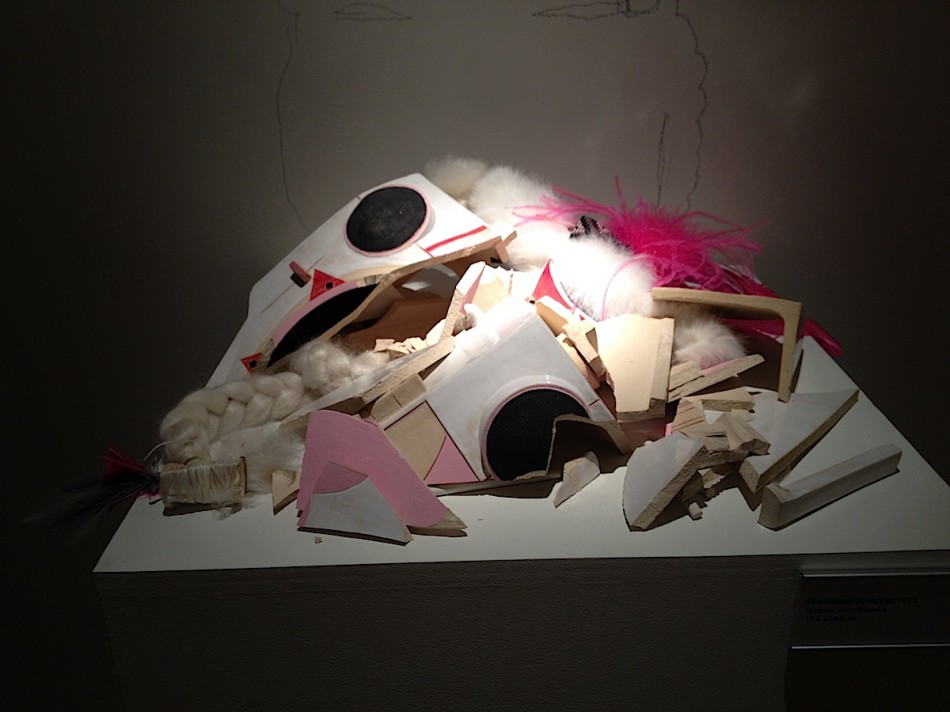
The Indian Princess, by Cannupa Hanska Luger
Symbol and Appropriation: New Visions in Contemporary Native American Art
Art museum as site that reifies majority-culture prerogatives of acquisition, appropriation, display and narrative underpinned a contemporary Native American art exhibition that closed at Museum of Contemporary Native Arts in Santa Fe on December 31st.
Cannupa Hanska Luger STEREOTYPE: Misconceptions of the Native American dealt in the imposed meanings on native cultures and identity that can have pernicious effects.
The artist’s sculptures — titled “The Curtis,” “The Barrymore,” “The Drunk,” “The Indian Princess,” “The Big Chief,” “The Ghost,” “The Plastic Shaman” — occupied a row of pedestals across from four sound-broadcasting ceramic pieces, Spring, Summer, Autumn, and Winter. All the sculptures spoke in object language, offering up piles of deconstructed signifiers or audio remixes. Heaped onto the pedestals were broken ceramics, bent eyeglasses, busted dreamcatchers, dyed feathers, potsherds with Andrew Jackson’s face (author of the Indian Removal Act) glued on. Silhouetted faintly onto the wall behind each one was an outlined pencil drawing, a kind of Rorschach test of “What do you see?” Faintness evoking erasure, the pencil drawing suggested how meaning both empties out and desires to be filled in — likely unsuccessfully, judging by the “stereotype” and “misconceptions” of the title.
Unfortunately, in providing seven-plus pages of wall text for work that occupied a single gallery, the artist undermined a viewer’s experiences with pedantry that squelches the pleasures of looking with a prescriptive monologue.
The texts elaborated on what the artist had meant by “stereotype” and “misconceptions.” For example, “The Curtis” referenced the photographer Edward S., who had willy-nilly composed photographs in which he presented members of one tribe wearing another’s ritual garb, with no regard for integrity. “The Barrymore” denoted Drew, who had posted a Facebook profile picture of herself throwing a peace sign and wearing a Native American headdress and a Budweiser apron.
“Adopting a culture without context or understanding drags the stories and histories through the mud,” Luger wrote. Native American “regalia” had become “symbols without power.”
What belongs to us and what doesn’t, and “who says,” culturally speaking, remain politically charged issues. But to my thinking, Drew Barrymore’s selfies are hardly a threat to any group’s identity given that “celebrity” is such a costume-fiction overall, mandating digital reincarnations at millisecond intervals.
Thus I entered with relief into Changing Hands: Art Without Reservation 3, the ultimate part of a multi-year traveling exhibit showcasing contemporary Native art from various North American regions.
Organized by New York’s Museum of Art and Design, this “3” episode featured artists from the northeast and southeast. The survey was full of gorgeous, pertinent, political and apolitical work. Jeffrey Gibson’s “Everlast,” a boxing bag, itself was a postmodern palimpsest of surfaces. I was astonished in front of Carla Hemlock’s quilted “Tribute to the Mohawk Ironworkers,” across from Donald Babe Hemlock’s interpretation in maple, pine and ash woods of “Mohawk Ironworker’s Cradleboard.” Kent Monkman’s performance-art drag-costumery-like “Dreamcatcher Bra, Raccoon Jockstrap and Quiver” was at once hilarious and loaded with beauty, sex and grotesquerie. One could approach this work with a sense of déjà vu — whether to groundbreaking Native postmodern artists like Hachivi Edgar Heap of Birds, Jimmie Durham or Hulleah Tsinhnahjinnie. One could also face anew Melanie Printup Hope’s mixed-media installation, “Sign of the Cross,” and be struck by its fresh invocation of ritual and the sacred in a combine of new technology, handcraft, and potent symbols.
The artists here effectively all said “yes” to postmodern strategies articulated in the epigram of Craig Owens’s essay, “The Allegorical Impulse”: Walter Benjamin’s thought that “Every image of the past that is not recognized by the present as one of its own concerns threatens to disappear irretrievably.”
Part of what seems afoot in contemporary art museums isn’t just that artists of Native America are making political subject matter new with a commentary gamut on Native boarding schools, feminism, mapping, tribal status, public versus ritual fashion, stereotypes, and racism. Also at work is our mash-up culture. From Hopi reggae to white-boy rap, images appear and disappear at such speeds that it can be difficult to grab the very point of endurance, archiving and “history” that are what embed at the foundation of any museum.
As I was leaving MoCNA, I stopped at the gift shop. I can certainly say that my consciousness about desire to consume beautiful and power-laden objects had been raised by Luger. My attention also flickered between the cases and my own iPhone which had rarely been out of my reach even in the galleries.
Why was that? Was I too about to broadcast where I’d just been so that a few of my Facebook friends might “like” it? Was there a simple way to sum up the intensity of the ideation, even the fever, of the energy that artists had spent on the work enclosed inside these walls?
And as to the disunity of words and objects, it can simultaneously be true that I don’t intend to do cultural harm when I go to a museum, but that museums’ histories include being material looters straight into the present. (Witness the December auction in Paris, or the “expeditions” that drove up to tribal lands and carted off the “museum-quality” goods. ) So if all this construes that there really shouldn’t be any end to pointing out how that was — and is — wrong, is there a simultaneous — even contradicting — reality in which admiring the work, isn’t?
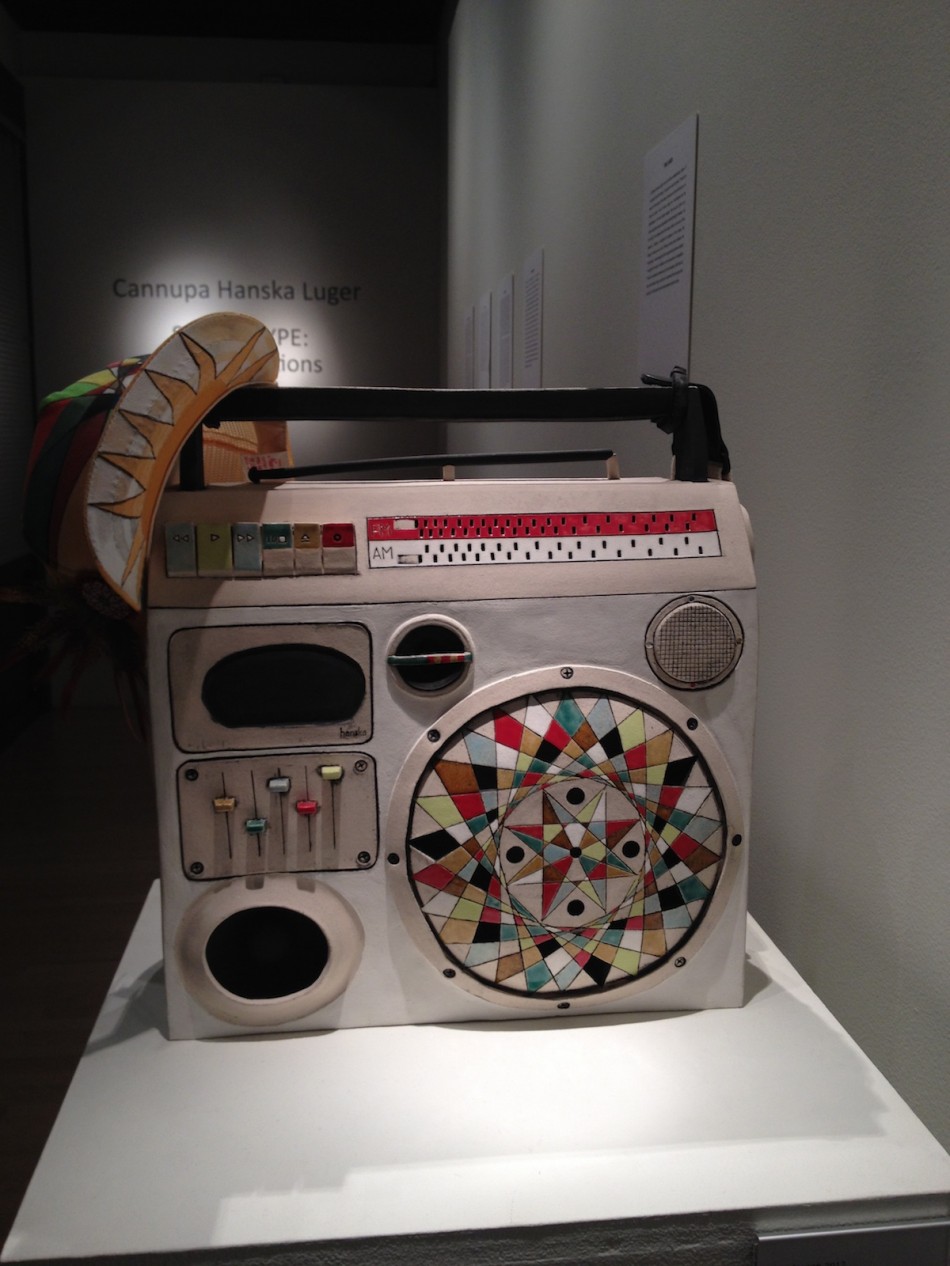
Cannupa Hanska Luger’s self-portrait, The Luger
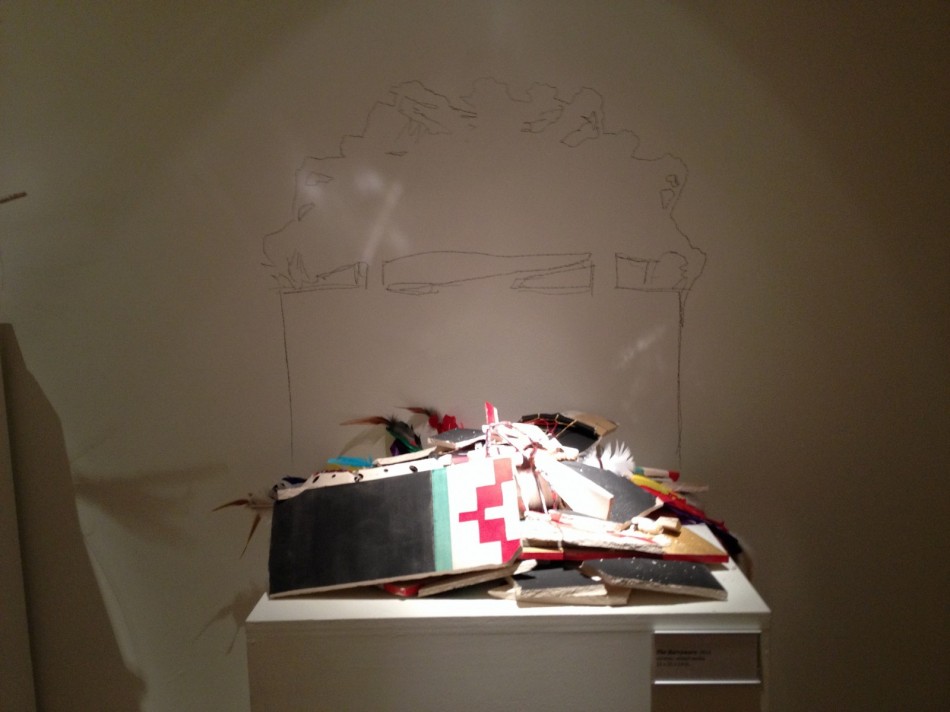
Cannupa Hanska Luger’s The Barrymore
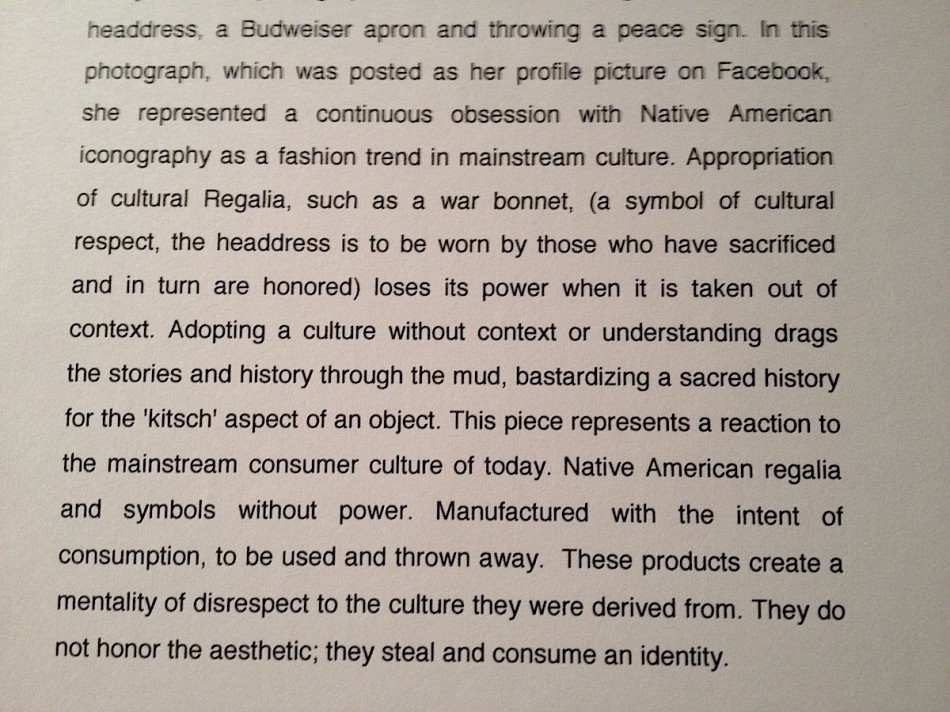
Wall text by Cannupa Hanska Luger

Melanie Printup Hope, Sign of the Cross
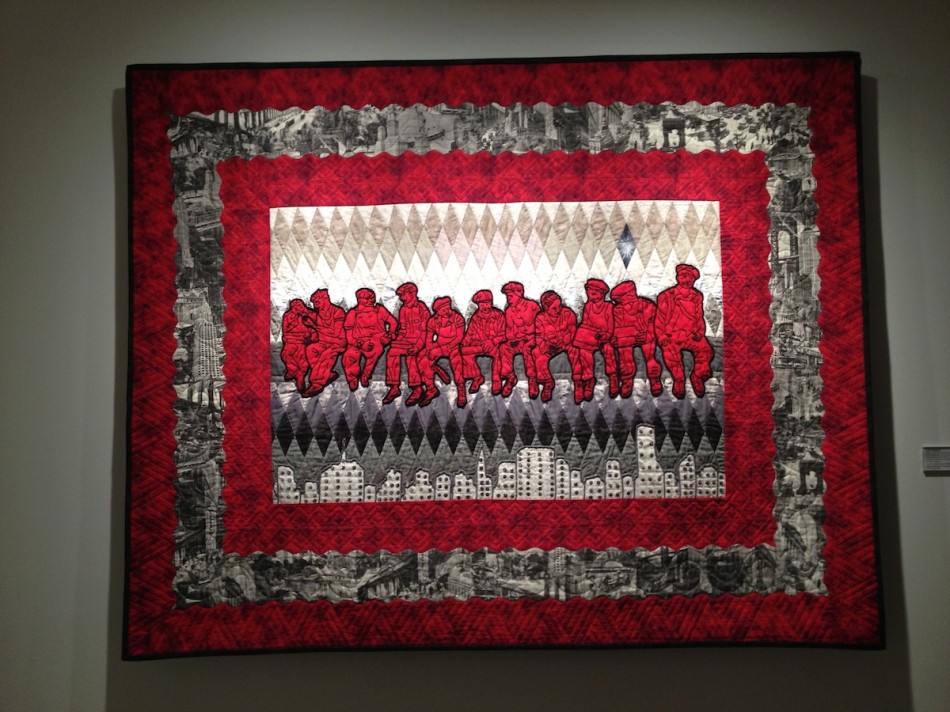
Carla Hemlock, Tribute to the Mohawk Ironworkers, 2008
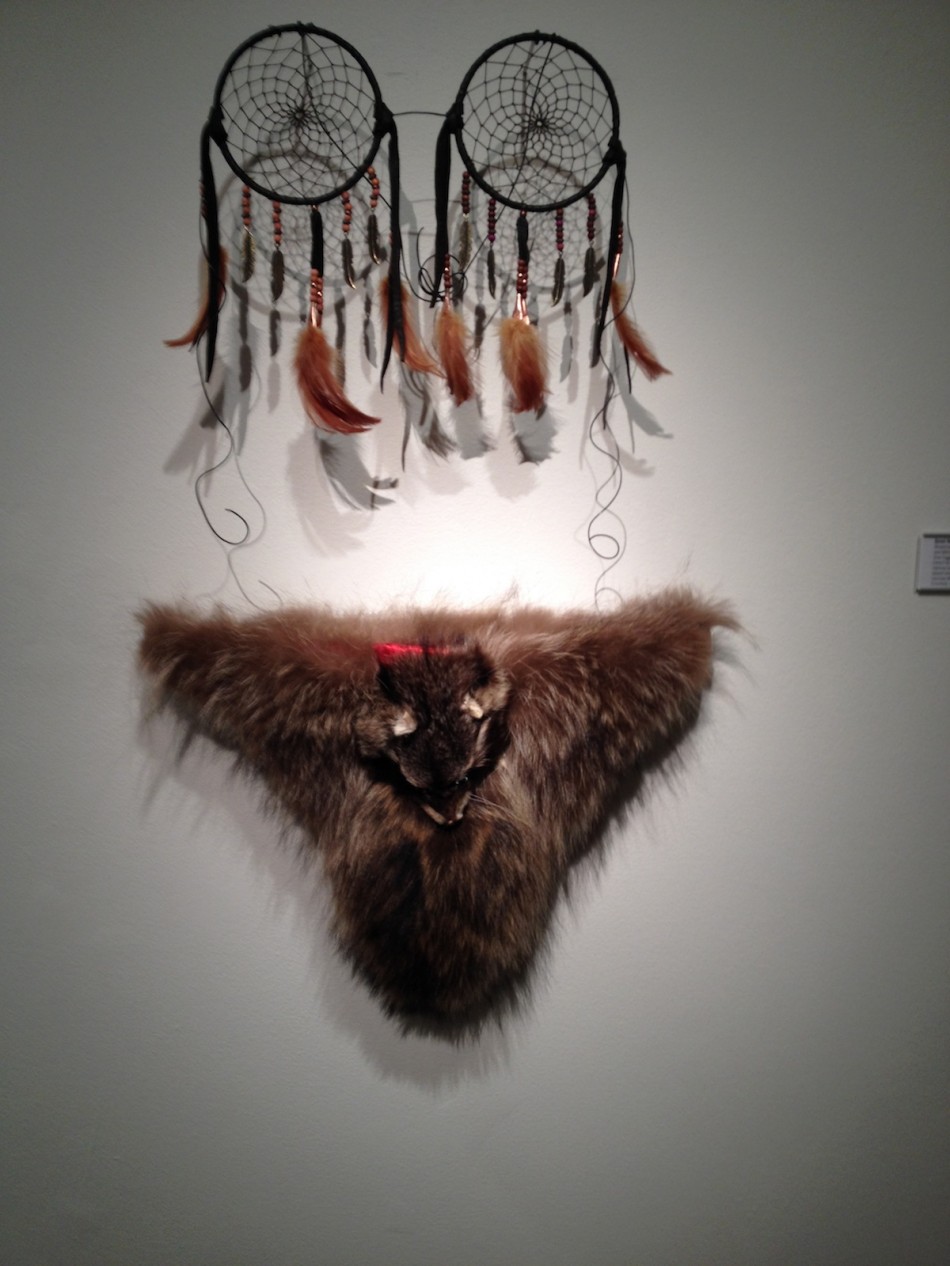
Kent Monkman, Dreamcatcher Bra, Raccoon Jockstrap, Quiver, 2007
